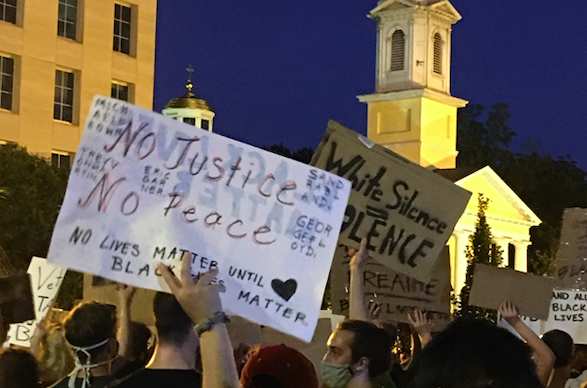
WASHINGTON DC –The zone of incomprehension was about a foot wide. That was the distance separating a boisterous but peaceful crowd of several hundred protesters and a silent line of several dozen uniformed Airborne Rangers in downtown Washington DC on Wednesday night. A young black woman in long braids patrolled the zone with a bullhorn, alternately telling the protesters to stand back and addressing the soldiers herself. “We are trying to humanize you,” she said. “You can humanize us.”
The distance between the two groups was about a foot but it could have been a thousand miles. On one side, a multicultural throng of men and women of carrying signs like “Racism is a pandemic” and “End the carceral state” and “We’re not trying to start a race war. We’re trying to end one.”
On the other side, stood a mute, monocultural band of males acting on the orders of President Trump and Gen. Mark Milley, chairman of the Joint Chiefs of Staff, whom Trump put in charge of responding to the nationwide (and worldwide) protest against U.S. police violence. Only few soldiers engaged with the protesters, sharing names and a smile, and then lapsing into silence.
“Why do you protect a racist?” shouted burly blonde white guy. A rotund black man held up his phone to show another soldier a video. “Look, they shot the dude as he got out of the car. Is that really what you want to do?” No answer.
One moon-faced solder tried hard to avoid eye contact, his face bright with sweat. A grim thirtysomething soldier squinted up and down the line from behind his plexiglass visor. I think I saw a trace of tears in the nervous eyes of the red-headed guy next to him. With the exception of one Latino and one black soldier, they were all white. Most of them looked to be in their mid-twenties. None of them wore name tags They stood two deep, behind plexiglass shields, all the way across 16th Street. Behind them you could see older men in blue uniforms—no name tags, no identifying insignias–speaking into earpieces. They were the ones who would give the orders when curfew came.
A block and half away stood the White House, now boxed in by a black chain link fence. Looming overhead was the steeple of St. John’s Church, where Trump appeared Monday after Attorney General Bill Barr ordered soldiers to use teargas and rubber bullets to rout a peaceful crowd from Lafayette Square.
“Just doing my job,” said one of the few soldiers who spoke. “You don’t have to do your job,” replied a black man with dreads. “You can put that gun down and lead us on a peaceful march right now to where he [Trump] lives.”
Some of the soldiers looked hostile, other confused. Mostly, they were stolid but uncertain, as well they should have been. Military discipline was under pressure, and not just from the crowd. The notion that the president’s actions violated the Constitution had just boiled up from within the armed forces themselves.
Earlier in the day, former Defense Secretary James Mattis denounced Trump’s deployment of the military against the protesters. Current Defense Secretary Mark Esper broke with the president and said calling in the U.S. military was not necessary. Before nightfall, former Four Star Army General John Allen published a piece, declaring “Monday was awful for the United States and its democracy.”
I doubt the soldiers on 16th Street knew or cared what the former generals thought. I’m sure they didn’t think of themselves as racist but they didn’t seem to be spoiling for a fight either (unlike the cops I covered in Occupy DC eight years ago.) As other commanding officers were rushing to assure their troops that their mission was to defend freedom of speech and assembly, not crush it, such alarms must have seeped down into the ranks. Or so I hoped.
What’s a soldier supposed to do when other soldiers say the commander in chief is not worthy of command responsibilities? Obey orders, of course. These men felt they had no choice but to stand their ground, but that ground was trembling with tectonic change as profound as anything in America since 1968. A national uprising against systemic racism had once again come face to face with the status quo, which they had been ordered to protect, by use of deadly force if necessary. The murder of George Floyd had brought them face to face but no closer to understanding. Orders were orders, the ethic of many a massacre.
“Look over here,” shouted a black woman at the moon-faced boy. “Look at me. We have been brutalized for four hundred years! Four hundred years! Do you feel our pain yet?” No answer.
So it went for a couple of hours. “Hands up!/Don’t Shoot, Hands up!/Don’t Shoot,” chanted the crowd with fingers high in the air. A guy dressed as Batman showed up and gave a speech. Someone projected the slogan “Demilitarize the Police” on the side of the Hay Adams Luxury Hotel and everyone cheered.
As the 11 pm curfew passed, I assumed the soldiers would soon charge and clear the street. They didn’t budge. As the night wore on, the crowd started to melt away. Someone in a position of authority had finally showed restraint. I came expecting the worse and was glad to be wrong. But when I looked at that one-foot wide zone of incomprehension, I saw an abyss.


